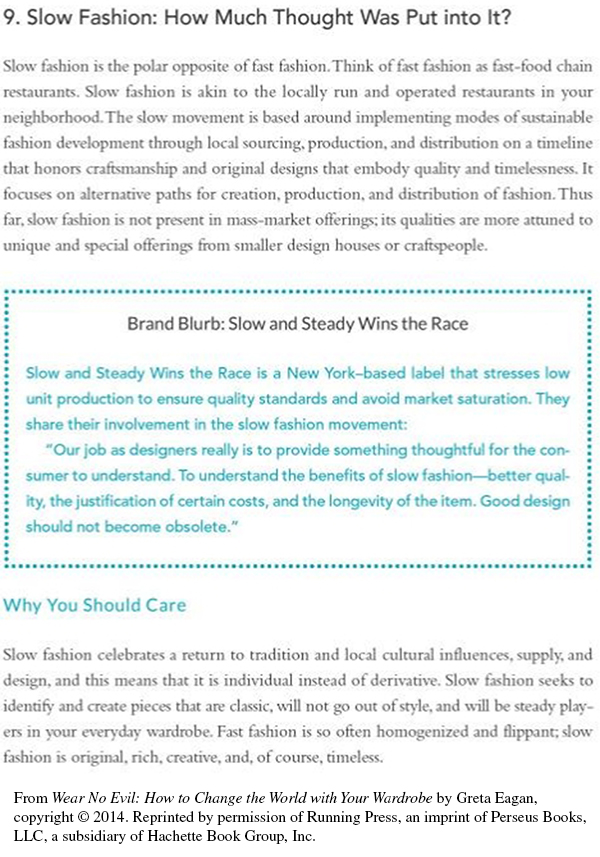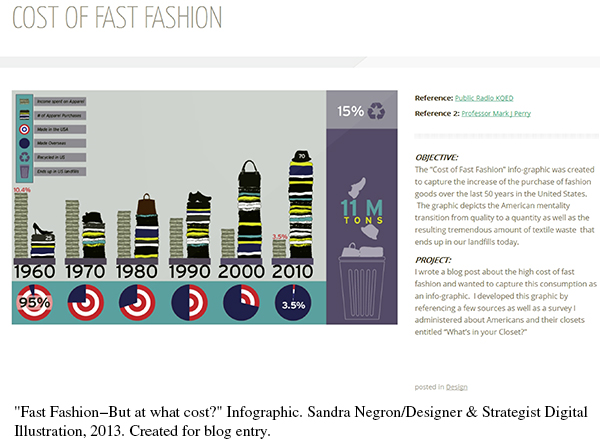Chapter 11.
Chapter 11: Genre Talk
Click to enlarge the images and view the book excerpt from Wear No Evil: How to Change the World with Your Wardrobe by Greta Eagan and the “The Cost of Fast Fashion” infographic by artist and designer Sandra Negron. Both documents argue against the trend of “fast fashion.” Check your understanding of genre by answering the following questions. Then “submit” your work.


The text reads as follows: Heading: 9. Slow Fashion: How Much Thought Was Put into It? Text: Slow fashion is the polar opposite of fast fashion. Think of fast fashion as fast-food chain restaurants. Slow fashion is akin to the locally run and operated restaurants in your neighborhood. The slow movement is based around implementing modes of sustainable fashion development through local soucing, production, and distribution on a timeline that honors craftsmanship and original designs that embody quality and timelessness. It focuses on alternative paths for creation, production, and distribution of fashion. Thus far, slow fashion is not present in mass-market offerings; its qualities are more attuned to unique and special offerings from smaller design houses or craftspeople. Next is boxed text that reads as follows: Box heading: Brand Blurb: Slow and Steady Wins the Race Box text: Slow and Steady Wins the Race is a New York–based label that stresses low unit production to ensure quality standards and avoid market saturation. They share their involvement in the slow fashion movement. Our job as designers really is to provide something thoughtful for the consumer to understand. To understand the benefits of slow fashion—better quality, the justification of certain costs, and the longevity of the item. Good design should not become obsolete. The main text continues as follows: Heading: Why You Should Care Text: Slow fashion celebrates a return to tradition and local cultural influences, supply, and design, and this means that it is individual instead of derivative. Slow fashion seeks to identify and create pieces that are classic, will not go out of style, and will be steady players in your everyday wardrobe. Fast fashion is so often homogenized and flippant; slow fashion is original, rich, creative, and, of course, timeless.
This infographic includes information for each decade from 1960 to 2010. For each decade, it shows the following information, which is described in the key on the left: -Income spent on Apparel (in percent) -# of Apparel Purchases -Made in the USA (in percent) -Made Overseas (in percent) It also includes two statistics for the whole infographic: -Recycled in US (in percent) -Ends up in US landfills The top part of the infographic shows income spent and number of apparel purchases in an illustrated bar graph. (Income is represented by a bar drawn as a stack of money; number of apparel purchases is represented by another bar drawn as a stack of clothing.) Each decade (1960, 1970, 1980, 1990, 2000, and 2010) has two bars showing the two sets of data. The highest income spent was in 1960, at 10.4%. The lowest income spent was in 2010 at 3.5%. The other decades vary, but in general, show a gradual decrease per decade. The bottom part of the infographic shows a set of circle graphs (one per decade) showing the data for Made in the USA vs. Made Overseas. In 1960, 95% was Made in the USA, 5% Overseas. By 2010, only 3.5% was Made in the USA, and 96.5% Overseas. The remaining decades show the gradual decrease of Made in the USA and the resulting increase of Made Overseas. In 1970, about 75% was Made in the USA, 25% Overseas; in 1980, about 62.5% was Made in the USA, 37.5% Overseas; in 1990 it was about 50/50; and in 2000, only 37.5% was Made in the USA, 62.5% Overseas. (The 2000 graph shows the opposite of the 1980 graph.) On the right side of the infographic it shows the following statistics: -Recycled in the US: 15% -Ends up in US landfills: 11 M tons Beside the infographic on the right is the following text: Reference: Public Radio KQED Reference 2: Professor Mark J. Perry Objective: The Cost of Fast Fashion info-graphic was created to capture the increase of the purchase of fashion goods over the last 50 years in the United States. The graphic depicts the American mentality transition from quality to quantity as well as the resulting tremendous amount of textile waste that ends up in our landfills today. Project: I wrote a blog post about the high cost of fast fashion and wanted to capture this consumption as an info-graphic. I developed this graphic by referencing a few sources as well as a survey I administered about Americans and their closets entitled What's in your Closet?
Question
1. The excerpt from Wear No Evil uses which of the following design elements?
Question
2. Which of the following facts can be inferred from the “Cost of Fast Fashion” infographic?
Question
3. Which of the following elements is NOT included in the infographic?